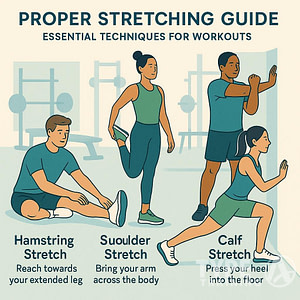Deciding how often you should train with a personal trainer depends on various factors like your fitness goals, budget, and workout experience. Working with a personal trainer has undeniable benefits, and understanding their role will help you determine the ideal frequency of your training sessions.
For beginners, it is essential to establish a consistent workout routine and master the basics of training. It is generally recommended for them to train with a personal trainer twice a week. This allows you to learn new exercises and techniques and perfect your form to prevent injuries. As your fitness level progresses, you may adjust your session frequency to further align with your individual fitness goals and budget.
Key Takeaways
- A personal trainer helps you in establishing a consistent workout routine and achieving your fitness goals.
- Beginners typically benefit from working with a personal trainer twice a week for faster progress.
- Adjusting session frequency as your fitness level progresses helps you balance your budget and achieve your goals.
Understanding the Role of a Personal Trainer
A personal trainer plays a crucial role in helping you achieve your fitness goals. They assess your current fitness level and tailor a workout plan to suit your needs. This individualized approach ensures that the exercises are both challenging and effective in achieving the desired outcome.
Popular posts:
An essential aspect of working with a personal trainer is learning proper form and technique. This enables you to perform exercises correctly, reducing the risk of injury and ensuring maximum benefit from each movement. Additionally, mastering these skills boosts your confidence and independence in the gym.
Personal trainers also offer motivation and support throughout your fitness journey. They provide encouragement, guidance, and are dedicated to helping you overcome challenges. This motivational aspect can make the difference between sticking to your fitness plan and giving up too soon.
Here are some key points to consider:
- A personal trainer works with you to set realistic goals based on your fitness level, ensuring that you make steady progress.
- Their expertise allows them to identify areas of improvement, from specific muscle weaknesses to new challenges.
- Personal trainers can adjust your workouts over time to keep your body guessing and prevent plateaus.
- They provide support and advice on various aspects of fitness, including nutrition and lifestyle changes, for a comprehensive approach to health and well-being.
Assessing Your Personal Fitness Goals
To determine how often you should train with a personal trainer, it is essential to assess your personal fitness goals. Start by identifying what you want to achieve, whether it is increasing strength, losing weight, building muscle mass, or improving overall health.
For strength-focused goals, target specific muscle groups or aim for overall body strength. List the exercises that address these muscles and gradually increase the intensity as you progress. Training with a personal trainer 2-3 times a week is recommended for beginners and can be adjusted based on individual needs and recovery time.
If your goal is to lose weight, a combination of cardio and resistance training is crucial. With a personal trainer, establish a workout plan that incorporates both elements to maximize fat loss while maintaining muscle mass. It is recommended to train with a personal trainer 2-4 times a week for the first six weeks if you are a beginner or returning after a long time.
Building muscle mass involves focusing on specific muscle groups and progressively overloading them to stimulate growth. A personal trainer can guide you on proper exercise technique, optimal workout frequency, and nutrition. For faster progress, train with a personal trainer two times a week, ensuring you provide your body with enough recovery time.
Lastly, for overall health improvement, consider working on aspects like flexibility, balance, and cardiovascular endurance. This is where a personal trainer can create a well-rounded fitness program tailored to your specific needs.
Remember, your personal fitness goals determine how often you should train with a personal trainer. Regular sessions will ensure steady progress and proper guidance for optimal results. As you gain experience and confidence in your workouts, your training frequency can be adjusted to fit your evolving fitness journey.
Determining the Suitable Frequency of Training
image credit: nsca.com/education
The optimal frequency of working out with a personal trainer depends on your goals, fitness level, and lifestyle. The general guideline for beginners is to train with a personal trainer twice a week, to ensure steady physical progress and an optimal learning pace1. As you become more advanced, you may adjust your training frequency to suit your specific needs.
To create a consistent gym schedule, consider factors such as your current exercise experience, available time, and desired outcomes. If you lead a mostly sedentary lifestyle, incorporating regular workout sessions with a personal trainer may help kick-start your fitness journey and boost motivation.
Beginners: If you are new to exercising, begin with 2 sessions per week with a personal trainer. This allows you to gain familiarity with different exercises, receive guidance on proper form, and build foundational strength and endurance.
Intermediate: Once you are comfortable with basic exercise techniques and have established a consistent routine, you can increase training frequency to 3-4 sessions per week. This offers balance between challenge and recovery, contributing to long-term, sustainable results.
Advanced: Highly experienced exercisers may benefit from more frequent training sessions, depending on their goals. For instance, if you aim to improve performance in a specific sport or discipline, you might train up to 5-6 times per week under the guidance of a personal trainer.
Keep in mind that regardless of your training frequency, it is crucial to allow sufficient recovery time between workouts. A general rule is to allow at least one day, but no more than three days between sessions that stress the same muscle group2. This helps prevent injury and promotes optimal muscle growth and repair.
In conclusion, determining the suitable training frequency with a personal trainer depends on your individual needs, goals, and fitness level. Establishing a consistent workout routine will help you progress and maintain an active, healthy lifestyle.
Footnotes
Building Efficient Workout Routines
As you start your journey with a personal trainer, it’s crucial to establish efficient workout routines. To do this, you’ll need to focus on various elements of exercise, such as workouts, techniques, and targeting major muscle groups.
Incorporating a variety of exercises in your workouts will ensure that you’re hitting all the essential muscle groups. A mix of full-body workouts, pulling movements, and targeted exercises for specific muscles will help you achieve a well-rounded and balanced routine. To make the most of your time with a personal trainer, it’s beneficial to meet two to three times a week for beginners to maximize progress and establish a solid foundation.
When building your workout routines, it’s essential to include both cardiovascular exercises like running and cycling, as well as strength training to develop physical endurance and muscle mass. Feel free to use this table to get a quick overview of the key aspects and benefits of each type of exercise:
| Type of Exercise | Key Aspects | Benefits |
|---|---|---|
| Cardio | Running, Cycling | Stamina, Heart Health, Fat Loss |
| Strength Training | Full-body workouts, Pulling movements | Muscle Growth, Joint Stability, Bone Density |
One crucial aspect of training is developing proper form and technique. Your personal trainer will teach you the right way to perform exercises, ensuring that you are engaging the correct muscles and not straining other parts of your body. This attention to detail will help prevent injuries and maximize the effectiveness of your workouts.
Remember to always prioritize quality over quantity in your workout routines. Focusing on your form and performing a lower number of well-executed repetitions is far more beneficial than trying to push through an excessive number of reps with poor technique.
By carefully planning your workout routines, maintaining consistency in your exercise schedule, and working closely with your personal trainer, you will be well on your way to achieving your fitness goals.
Importance of Rest and Recovery
When you incorporate personal training into your fitness routine, it’s crucial to understand the importance of rest and recovery. Regular exercise, particularly with a personal trainer, can lead to significant improvements in your strength, endurance, and overall well-being. However, without proper rest and recovery, your progress may be hindered.
Your muscles need time to recover after intense workouts. During the recovery phase, your body repairs damaged muscle tissue and replenishes energy stores, or muscle glycogen. This process is essential for muscle growth and prevention of injuries.
In order to optimize your rest, consider the following factors:
- Frequency of training sessions: You should maintain a balance between working out and resting. Too many personal training sessions can lead to overexertion, while too little training may not yield the desired results. It’s essential to find a schedule that suits your individual needs and promotes a healthy lifestyle.
- Muscle memory: When you learn new exercises or skills with your personal trainer, your muscles develop what’s known as “muscle memory.” Over time, your body becomes more efficient at performing these movements. However, if you don’t allow for adequate rest, your muscle memory can suffer, making it harder to perform the exercises correctly.
- Lifestyle changes: It’s not just about how often you work out, but also how you live your life outside of the gym. Proper rest and recovery entail getting enough sleep, maintaining a well-balanced diet, and managing stress levels. Incorporating positive lifestyle changes can significantly impact your ability to recover and make the most of your fitness journey.
Here are a few tips to integrate rest and recovery into your workout regimen:
- Allow 24-48 hours of rest between working the same muscle group.
- Take an active rest day by engaging in low-intensity activities like walking or yoga.
- Prioritize sleep, aiming for 7-8 hours each night.
- Utilize foam rollers or massage to promote muscle relaxation.
- Stay hydrated and fuel your body with nutrient-rich foods.
In summary, giving your body the rest it needs is just as important as your personal training sessions. By embracing this mindset, you’ll achieve more significant gains, optimal performance, and a safer workout experience.
Balancing Budget and Fitness Needs
When considering how often to train with a personal trainer, it’s important to find the right balance between cost and your fitness needs. As a beginner, experts recommend starting with two to three sessions per week to ensure steady progress while learning proper technique.
However, personal training can sometimes be expensive, so you should keep your budget in mind when planning the frequency of your sessions. If finances are tight, reducing sessions to once a week can still help you stay accountable and consistent in your fitness journey.
When thinking about cost, it’s crucial to factor in the potential for reduced availability of your trainer. Trainers may have different rates or schedule preferences, which could affect the number of sessions you are able to afford and fit into your own schedule. Explore different pricing options, such as group sessions or discounted package rates, to make personal training more accessible.
Here’s a quick overview of the suggested session frequency based on experience and fitness levels:
- Beginners: 2-3 sessions per week
- Intermediate: 1-2 sessions per week
- Advanced: 1 session per week
Ultimately, the balance between your fitness needs and budget will determine how often you should train with a personal trainer. Prioritize your goals while staying financially responsible, and make adjustments to your training schedule as needed.
Frequently Asked Questions
How many sessions per week are recommended with a personal trainer?
For beginners, it’s generally recommended to have two to three sessions per week with a personal trainer. This frequency helps ensure steady progress and optimal learning pace.
What is the ideal duration of a personal training session?
The ideal duration of a personal training session varies depending on your goals and availability. However, most sessions last for 45 minutes to an hour. This allows adequate time for warm-ups, exercise execution, and cooldown.
How long does it take to see results from personal training?
The time it takes to see results from personal training can vary based on factors such as individual goals, starting fitness level, and consistency. Generally, it may take four to six weeks of consistent training to notice significant improvements in strength, endurance, or weight loss.
Is a personal trainer necessary for every workout?
A personal trainer is not necessary for every workout. As you become more familiar with exercises and proper form, you can gradually reduce the frequency of your sessions with a trainer. Eventually, you can transition to training independently or check in with your trainer occasionally for guidance and adjustments.
What is the cost of training with a personal trainer multiple times a week?
The cost of training with a personal trainer varies based on factors such as location, experience, and session duration. On average, you may find prices ranging from $49 to $130 per session. Keep in mind that you might receive discounted rates for booking multiple sessions or small group training.
Can I achieve results with a personal trainer only once a week?
While less frequent, it is still possible to achieve results with a personal trainer once a week. However, it may take longer to reach your goals, and you should maintain a consistent workout routine outside of your sessions with the trainer.











